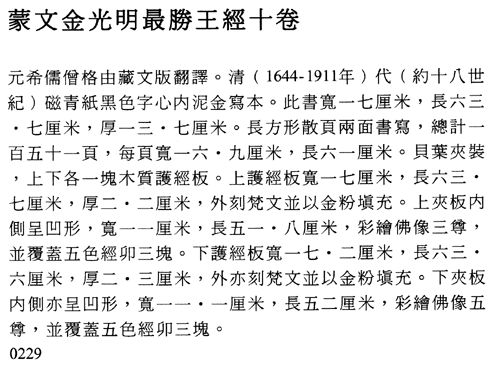| |

Sutra of the Golden Radiance of the Most Victorious Kings (Suvarnaprabhasottamaraja-sutra; Qutug-tu deged� altan gerel-t� sudur nugud-un qagan nere-t� yeke k�lgen sudur), 10 juan, in Mongolian Script
Qing dynasty (1644-1911), undated, ca. 18th century
Translated from the Tibetan by �es-rab Se�-ge (act. ca. 1323-67)
150 loose folios between top and bottom sutra covers and top and bottom carved wood covers; overall dimensions of ensemble: approx. 17.0 x 63.7 x 13.7 cm; top carved wood cover with Sanskrit script and decorative designs in relief over gilt ground, carved on both ends, flat on inside surface: 17.0 x 63.7 x 2.2 cm; top sutra cover covered in polychrome silk brocade with design of shou character roundels, bats, and clouds: 17.2 x 61.2 x 1.4 cm; recessed panel on inner side of top sutra cover: 11.0 x 51.8 cm, with illuminated panel protected by 3 layers of silk guards in various color combinations; sutra folios, texts inscribed in gold on black varnished ground and enclosed by double lines, with borders in indigo, each: approx. 16.9 x 61.0 cm; cover of bottom sutra covered in polychrome silk brocade with design of shou character roundels, bats, and clouds: 17.2 x 61.2 x 1.4 cm; recessed panel on inner side of bottom sutra cover: 11.1 x 52.0 cm, with illuminated panel protected by 3 layers of silk guards in various color combinations; bottom carved wood cover, with Sanskrit script and decorative designs in relief over gilt ground, carved on both ends, flat on inside surface: 17.2 x 63.6 x 2.3 cm
Inventory number: 0229
The Suvarnaprabhasottamaraja-sutra (Sutra of the Golden Radiance of the Most Victorious Kings) is one of the most important and popular Mahayana scriptures; it is often abbreviated as the Suvarnaprabhasa-sutra (Sutra of the Golden Radiance). The "most victorious kings" in the full title refers to the deva kings who came to pay homage to the Buddha. It is the one sutra in which a number of sensitive topics, such as the relationship between the state and Buddhism or the responsibilities of rulers, are addressed in several of its nineteen chapters but in a manner that is at once aesthetic, appealing, and impressive. For instance, an entire chapter is devoted to medicine and healing, in which the connection between medical and religious practices is reinforced. In the chapter on laws, the sutra makes it clear that religion and government are linked by Buddhist dharma.
The Mongolian version, first translated from the Tibetan by the Saskya monk �es-rab Se�-ge (also written as �irab Sengge), is known in full as the Qutug-tu deged� altan gerel-t� sudur nugud-un qagan nere-t� yeke k�lgen sudur but is often simply called the Altan gerel (Golden Radiance). Mongolian script, written downward in vertical columns, is derived from the Uighur, which in turn was borrowed from the Sogdian and the Aramaic.
This copy of the Suvarnaprabhasottamaraja-sutra is richly presented in a large pothi-sized book format kept between unconnected carved ebony covers, in a manner derived from the palm-leaf pothi of Indian Buddhist literature. The top cover contains a single line of Sanskrit text in Devanagari script, flanked on the left by the letter representing ga (the third consonant) and on the right by a letter conventionally used in mantras. Recessed panels on the inner sides of both the top and bottom wooden covers have silk guards in various colors and are decorated with illuminated miniatures of Lamaistic gods.
This sutra consists of 150 loose folios beginning with the one numbered "two," the first folio in the sequence having been embedded as the inner side of the top sutra cover. The loose oblong folios have inscriptions on both recto and verso, except the final leaf, which is inscribed on only one side and has two Buddhist icons flanking the text. Each folio has surrounding margins in indigo, while the text panels have inscriptions in gold on black ground, with a double border (thick on the outer edge and thin on the inner edge) in yellowish pigment. Each inscription has 38 to 40 columns of text. Pagination of each leaf is indicated in gold on the indigo paper surface along the left edge of the text or image panel. The bottom sutra cover is similar to the top one except that it has an illuminated panel with five icons (instead of three).
| |


